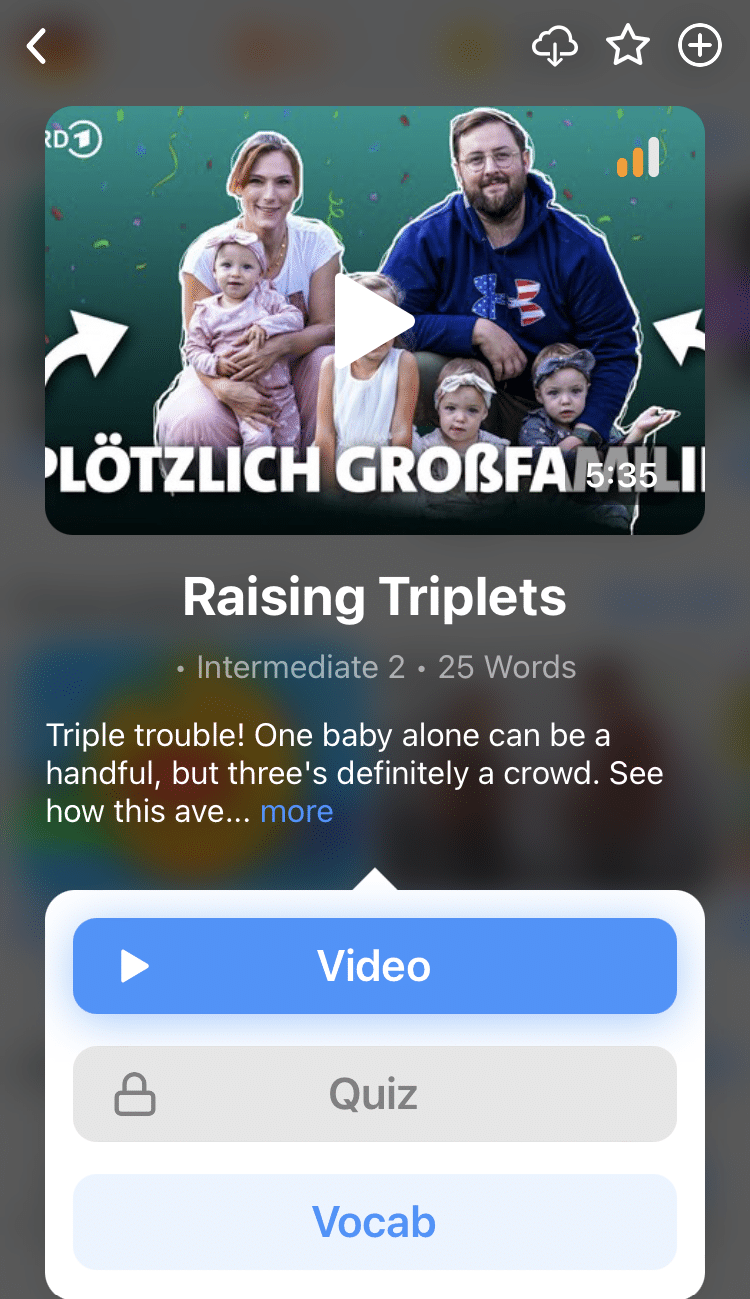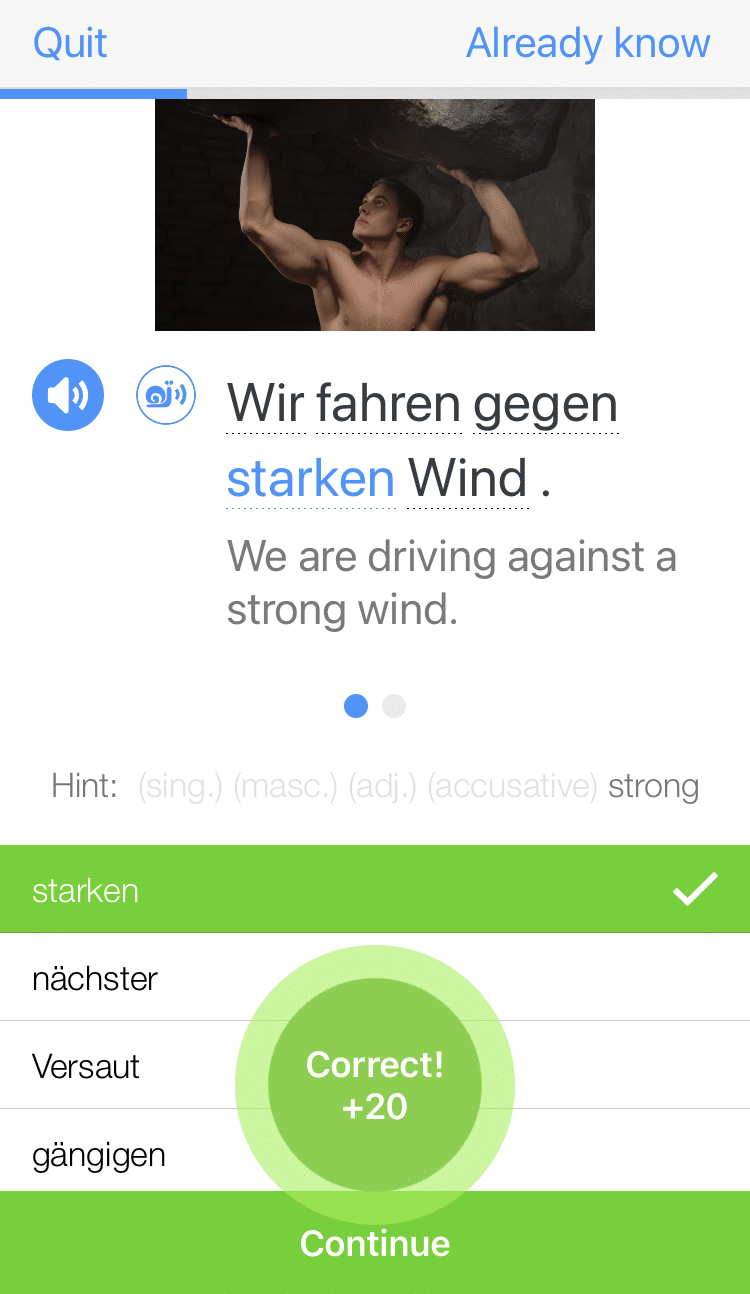
The Ultimate Guide to Der, Die and Das
The word “the” starts looking like the most beautiful, efficient word ever conceived once you start learning a new language—particularly German.
You’ve got the masculine der , the feminine die , the neutral das and the plural die . But! These articles change depending on the context of their use to sometimes become dem or den .
It’s one of the little nuances of the German language that has learners wanting to pull their hair out and potential learners giving up early in the game.
But let’s not be intimidated. We can crack this code together!
Contents
- General Rules for Using der, die and das
- The Akkusativ Case: Introducing den
- The Dativ Case: Introducing dem
- The Genetiv Case: Introducing des
- Practicing der, die, das, dem, den and des
- Tips for Learning der, die and das
- And One More Thing...
Download: This blog post is available as a convenient and portable PDF that you can take anywhere. Click here to get a copy. (Download)
General Rules for Using der, die and das
The article that comes before every noun may seem totally random, but there are some tricks (and obviously there are exceptions to every rule). For general reference, check out the following.
When to Use der
If a word ends with -or, -ling, -smus or -ig, it always has the masculine der article.
For example, the words der Motor (motor), der Feigling (coward), der Journalismus (journalism) and der Honig (honey).
When to Use die
If a word ends with -ung, -keit, -schaft, –tät, -ik, -tion, -heit or -ei, it always has the feminine article die.
For example, die Ahnung (idea), die Möglichkeit (possibility), die Wissenschaft (science), die Qualität (quality), die Semantik (semantics), die Situation (situation), die Dunkelheit (darkness) and die Bäckerei (bakery) all take the feminine die.
Very often—though not always—words ending with an -e also have the die article, like die Lampe (lamp).
Die is always used when speaking in plural (except in the Dativ case, which we’ll get to later). This can be a lifesaver sometimes. Just only speak of things in terms of two or more and you’re golden.
When to Use das
If a word ends with -chen, -ma, -um, -ment, -lein or -tum, it has the neutral article das.
For example, the words das Würstchen (sausage), das Schema (scheme), das Christentum (Christianity), das Medikament (medicine), das Fräulein (lady) and das Eigentum (property).
Also, it’s very common for technology, mechanical and science words to have the das article in German.
So we have a base to work from, at least. But there are a lot of German words, many of which do not have these endings. Unfortunately, knowing them is just a matter of memorizing the articles.
To get used to these articles, try noticing them in German media, like blog posts, videos, and movies. Eventually, they’ll become more intuitive! FluentU is one study tool that you can use for this.
FluentU takes authentic videos—like music videos, movie trailers, news and inspiring talks—and turns them into personalized language learning lessons.
You can try FluentU for free for 2 weeks. Check out the website or download the iOS app or Android app.
P.S. Click here to take advantage of our current sale! (Expires at the end of this month.)
The Akkusativ Case: Introducing den
Things get a bit more complicated when you start dealing with the Akkusativ case, which comes up when we have a “direct object”.
What is a “direct object”, you may ask? It’s simply when something is on the receiving end of the verb.
For example, “The boy sees the dog” or “We take the kids to the park.”
In both sentences, the dog and the kids are being acted upon, on the receiving end of the verbs “to see” and “to take”.
So what does being in the Akkusativ case mean? It means the articles for masculine nouns change: Der becomes den. Thankfully, all other genders stay the same.
So let’s put it in a sentence!
Examples of the Akkusativ Case
To keep the noun genders very clear, let’s talk about men and women. We can use the sentence, “The woman kisses the man.”
“Man” would obviously be masculine, der Mann, and “woman” would be feminine, die Frau. And because the man is on the receiving end of the verb (being kissed), he goes in the Akkusativ case.
Remember, the only article that changes is the masculine, so der Mann becomes den Mann. Therefore, the sentence is:
Let’s do one more for good measure. Now we want to say, “The boy throws the ball.”
“Boy” is der Junge, and as he is doing the throwing, he stays the same. But “ball” is der Ball, and as its on the receiving end of the verb (it’s being thrown), it becomes den Ball in the Akkusativ case. Therefore, the sentence is:
Prepositions That Take the Akkusativ Case
There are also several prepositions that are always followed by the accusative case. That means that regardless of what that thing is doing in the sentence, is goes in the accusative. Why? Because the prepositions say so.
Wir gehen durch den Wald. (We walk through the forest)
Durch (through) is always followed by the dative, so der Wald becomes den Wald.
Be sure to learn the prepositions that take the accusative, so no one can accuse you otherwise!
The Dativ Case: Introducing dem
There’s another case we need to look at: Dativ.
In the accusative case, we were dealing with the “direct object”. Well, the Dativ case is a bit more circuitous, so here we are dealing with the “indirect object”.
What does the indirect object do? It receives the direct object:
“Santa gives the child a present.”
“The present”, is the direct object, as its being given. “The child” is then the indirect object, as it’s receiving the direct object.
So what changes in the dative case?
When you’ve got a regular noun in the Dativ case, the article changes again, and this time, they’re all getting in on the fun:
Der becomes dem, die becomes der, das becomes dem and the plural die becomes den (and adds an -n on the end of the noun).
It’s a lot to remember. You might come up with your own, but I made a little acronym out of the ending letters: MRMN. Maybe you can add words to it, like Mother Rides Motorcycles Never, or Music Rubs Michael’s Nerves. I don’t know…
Just like the accusative, there’s a bunch of prepositions and verbs that are simply always followed by the dative case, like mit (with) and helfen (to help). Be sure to read our handy articles on those too!
Let’s just do a bunch of examples to nail it all home.
Examples of the Dativ Case
The teacher gives the pupil a book.
Here, the pupil (der Schüler) is receiving the direct object, the book. Since der becomes dem in the Dativ case, the sentence is:
Der Lehrer gibt dem Schüler ein Buch.
Next sentence:
The boy plays with the dogs.
Since we’re using the preposition mit, which always takes the dative, the following noun needs to go in the Dativ case.
The boy—der Junge—stays the same. But the dogs—die Hunde—becomes den Hunden. (The dative plural adds an -n on the end of the noun, remember!)
Therefore, the sentence is:
Der Junge spielt mit den Hunden.
One more. The sentence is:
The doctor helps the old woman.
Helfen (to help) is one of those verbs that is always followed by the dative, so die Frau (the woman) becomes der Frau. Therefore, the sentence is:
Der Arzt hilft der alten Frau.
Once you’ve mastered using articles in the Dativ case, you can learn how to use Dativ pronouns in German.
The Genetiv Case: Introducing des
You know how when you want to say that something belongs or relates to something, you simply use an of or ‘s? Like, “the front of the house” or “the woman‘s car”? Well, in German, there’s an entire case dedicated to just that! Presenting—the genitive!
You can just use von (of) to express possession, and this is often done in colloquial language. But in written or formal German, it is almost always preferable and more proper to use the genitive.
So, if you want to say “The start of the month” you would say: Der Anfang des Monats. No “of” needed here, it’s all contained within the des!
But what is des, you might have already wondered. Well, that’s just our old article friends changing again:
- The masculine der becomes des.
- The feminine die becomes der.
- The neuter das becomes des.
- The plural die also becomes der.
“But what about the -s on the end of Monat?” I hear you exclaim! That’s because in the genitive case, masculine and neuter nouns gain an -es or -s at the end.
Watch out when translating an English phrase like “the man’s dog”, as the word order is the reverse in German: Der Hund des Mannes. (literally, the dog of the man)
That’s why it can be quite very helpful to always think of the long-winded way of expressing possessives in English, as strange as they might sound: The girl’s laptop –> The laptop of the girl.
Examples of the Genitive Case
Let’s run through an example of each gender in this case:
Das Fell des Hundes ist schmutzig. (The dog’s fur is dirty. / The fur of the dog is dirty.)
The fur belongs to the dog, so der Hund goes in the genitive case, becoming des Hundes.
Der Computer der alten Dame funktioniert nicht. (The old lady’s computer isn’t working. / The computer of the old lady isn’t working.)
The computer belongs to the lady, so die Dame goes in the genitive case, becoming der Dame.
Die Rückseite des Hauses ist nach Süden ausgerichtet. (The backside of the house faces south.)
The backside refers to the house, so das Haus goes in the genitive, becoming des Hauses.
Ich räume die Spielsachen der Kinder auf. (I tidy up the children’s toys. / I tidy up the toys of the children.)
The toys belong to the children, so die Kinder goes in the genitive, becoming der Kinder.
Prepositions that take the Genitive Case
Just like the other cases, there are also a couple of prepositions that always take the genitive case like wegen (because of), aufgrund (due to), innerhalb (within), außerhalb (outside). Be sure to take a look at our article on prepositions to find out more about those.
Practicing der, die, das, dem, den and des
Take a breath. It’s not so bad. Think about it whenever you can.
If you sit down at table in a restaurant, tell yourself what’s on the table in front of you: Die Serviette liegt auf dem Tisch. Das Besteck liegt auf dem Tisch. Die Gläser stehen auf dem Tisch. (The napkin is on the table. The cutlery is on the table. The glasses are on the table.)
When you’re standing in line: Ich warte in der Schlange .
When you ride your bike over a rock: Ich fahre über den Stein.
And don’t forget that how a word ends can give you a clue as to its gender, so memorize those and practice, practice, practice.
Tips for Learning der, die and das
Learning the different articles in German can be made easier by following some helpful tips. It’s all about using the corresponding articles as you learn new words, and then paying close attention to them as they’re used in different contexts.
Consider the article an inseparable part of the word itself
When you’re learning German, do not simply learn the equivalent words as they are. So if you’re messing around on Google Translate, for example, and you want to know how to say the word “horse,” don’t just type in “horse.”
You’ll get Pferd. Instead, type in “the horse” so you get das Pferd. Same goes when asking a German-speaking friend. Ask for the article.
I’ve even heard of truly dedicated German learners posting sticky notes all over their homes, labeling every individual object with its German name. Do it! Just put the article on there as well.
If you use Vocabulary Stickers, you’ll get the benefit of pre-made labels coded by grammatical gender, ensuring that you learn over a hundred of the most common German words with the correct gender matched to each.
Another great way to become more comfortable with these articles is to see them used in context.
Train yourself to associate each article with its noun
As you consume German media, listen out for the German article in use in various situations. Subtitled content is especially useful for this, so seek out immersive language programs that use authentic German media with accurate subtitles like FluentU.
The more you listen to how and when the articles are used, the closer you’ll get to just knowing when they “sound right.” And remember, practice makes perfect!
There you have it, every way to say “the” in German, whatever the situation.
While it may seem intimidating at first, keep in mind that almost 100 million German speakers figured all of this out. You can, too!
Download: This blog post is available as a convenient and portable PDF that you can take anywhere. Click here to get a copy. (Download)
And One More Thing...
Want to know the key to learning German effectively?
It's using the right content and tools, like FluentU has to offer! Browse hundreds of videos, take endless quizzes and master the German language faster than you've ever imagine!
Watching a fun video, but having trouble understanding it? FluentU brings native videos within reach with interactive subtitles.
You can tap on any word to look it up instantly. Every definition has examples that have been written to help you understand how the word is used. If you see an interesting word you don't know, you can add it to a vocabulary list.
And FluentU isn't just for watching videos. It's a complete platform for learning. It's designed to effectively teach you all the vocabulary from any video. Swipe left or right to see more examples of the word you're on.
The best part is that FluentU keeps track of the vocabulary that you're learning, and gives you extra practice with difficult words. It'll even remind you when it’s time to review what you’ve learned.
Start using the FluentU website on your computer or tablet or, better yet, download the FluentU app from the iTunes or Google Play store. Click here to take advantage of our current sale! (Expires at the end of this month.)







